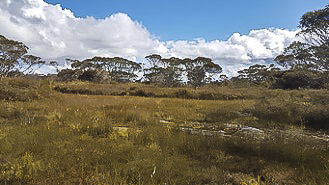Introduction
Every two years The Australian Native Plants Society of Australia (ANSPA) holds a conference which is hosted by each state in turn. In 2019 it was held in Albany, Western Australia and approximately 330 delegates attended. It was the turn of APS NSW last year, but due to COVID-19 was postponed until September this year where it was held at the Kiama Pavilion on the beautiful NSW south coast attracting approximately 360 people from all parts of NSW, interstate and overseas.
The theme for the conference was “Australian Flora – Past, Present, Future” which aimed at taking participants “back to the past to gain insight and appreciation of this land from thousands of years ago including the evolutionary history of the Illawarra- its geology and plants, to experiencing the beauty of the world and the threats it is currently facing from fire, weeds, feral pests, population growth and development. Finally, onto the future whereby solutions to better protect and enhance Australia’s unique floral heritage through regeneration, advances in horticulture, education, plant resilience, seed and plant conservation are being explored and developed in order to protect not just ourselves, but for all generations to follow” (Reference: ANSPA Online Conference Notes)
The Conference commenced on Saturday September 10 with a complimentary tour of the Kiama region for delegates who were attending for the entire week where they visited Shoalhaven Heads winery, the Berry School Nursery and Bombo Headland. On Sunday, everyone including members of the General Public, were able to purchase native plants, most of which were indigenous to the Illawarra region and later, a special Cocktail evening was held at the Pavilion to welcome all the delegates. At this event, the Mayor of Kiama, Neil Reilly welcomed everyone to the Conference and Kiama and then Liz, wife of the incoming ANSPA President John Aitkin, together with Christine Middleton and Sal’s Pals entertained guests with a song she composed about the Conference’s emblem, the Gymea Lily, much to the delight of all present!
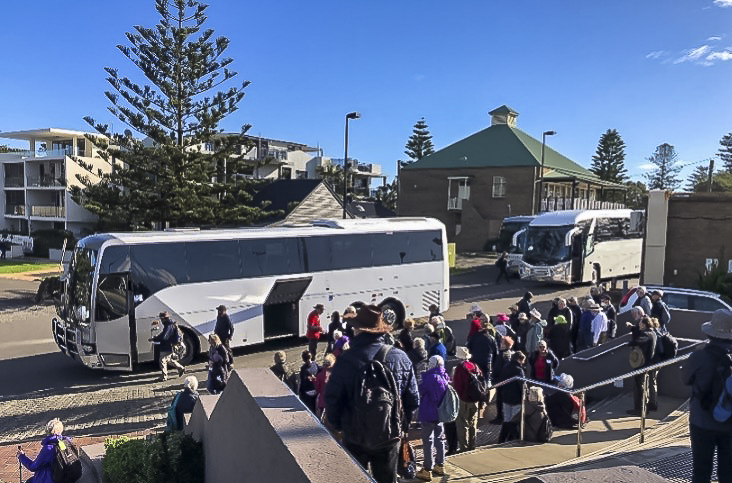
In between the sessions where there was a program of guest speakers, delegates also had the opportunity to attend pre and post Conference Tours to destinations such as the World Heritage Blue Mountains, Lord Howe Island, the Warrumbungles and the Pilliga, Sydney Sandstone Flora and South Coast NSW. These tours were paid for by the attendees and were usually between 5-7 days duration. Some of the people I met during the week over morning tea shared how much they enjoyed their time on Lord Howe Island and also the Blue Mountains World Heritage area.
Wednesday and Friday were also designated as complimentary excursion days for delegates who were attending for the week. The choices included full day trips via coach to either Royal National Park ( Wattamolla and Audley); Barren Grounds Nature Reserve including Minnamurra Rainforest and the Robertson Rainforest; Jamberoo Native Nursery, Minnanurra Rainforest and Illawarra Grevillea Park; Joseph Banks Native Plants Reserve and Kamay/Botany Bay National Park; Shoalhaven Heads Area; Fitzroy Falls and the Roberstson Rainforest; Silky Oaks ( Peter and Margaret Olde’s property) and Robertson Rainforest; or the Australian Botanic Gardens at Mt Annan and the Illawarra Grevillea Park. A guide accompanied each tour providing information about the specific areas and sights along the way and a lovely Morning/Afternoon tea and lunch was provided.
Barren Grounds excursion
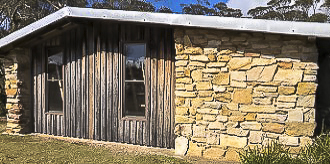
Jim and I attended the Conference on Monday and Tuesday and joined the Day Trip to Barren Grounds Reserve, Minnamurra Falls and the Robertson Rainforest on Wednesday. I had particularly wanted to go to Barren Grounds Nature Reserve as the last time I had visited was in the late 1980s when I had attended a Bird Banding workshop with the NSW Field Ornithologists Group (now Birding NSW) and I remembered the lovely heathlands through which I’d walked. Back then, there was a sandstone cottage where people could stay overnight if attending for a weekend. The stone cottage is still there but as far as I could make out not apparently in use.
Barren Grounds is also where there have been numerous sightings of the elusive and threatened Eastern Ground Parrot, but unfortunately it was not seen by anyone on this occasion. However, we did see some spectacular views and some equally beautiful wildflowers with our guides Tom Jordan and Lyndal Thorburn who have been associated with the Reserve since the 1980s.
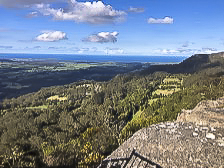 |
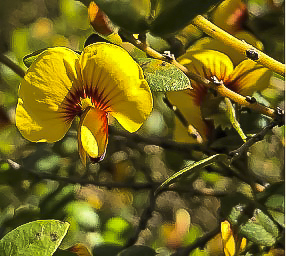 Bossiaea rhombifolia |
|
|
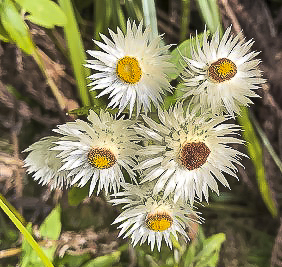 |
Before we got to Barren Grounds, we drove to Minnamurra Falls – well worth a visit if you have never been to this beautiful location in Budderoo National Park which is a sub -tropical and a warm temperate rainforest. We took the Lyrebird Loop Trail which wound upwards through the forest on a well- marked trail complete with suspension bridges and trail guides pointing out various plants and landscape features. Ancient Red Cedars (Toona Ciliata), Strangler Figs (Ficus Obliqua ) and giant Cabbage Tree Palms (Livistona australis) were but a few of the highlights together with the quiet deep pools of water and mossy boulders.
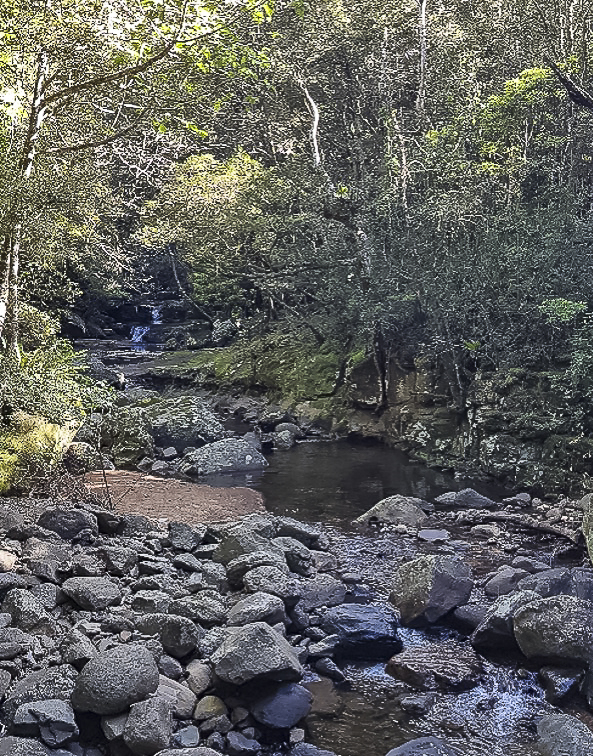 |
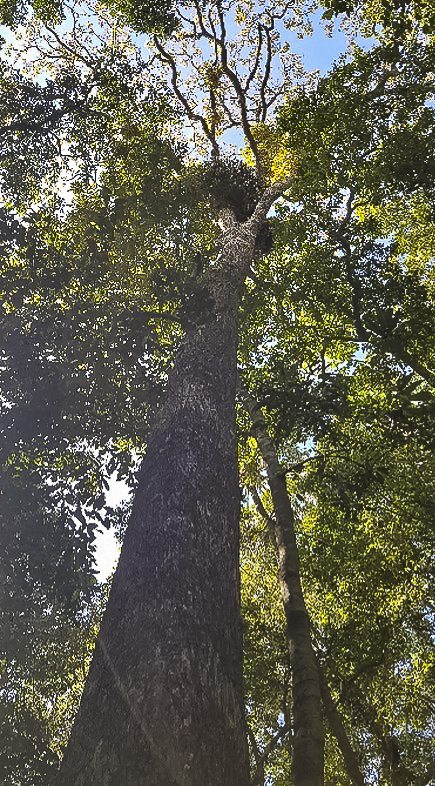 |
We enjoyed morning tea outside the Visitor Centre which has some interesting posters and gifts to purchase. From here we continued to Native Grace Plant Nursery at Robertson just outside of the township and newly established by an energetic couple. This is a speciality native plant nursery where plants such as Grevillea, Banksia and other native varieties can be purchased onsite or online. The Nursery also offers garden design and installation services across the Southern Highlands by qualified horticulturalists and landscape designers.
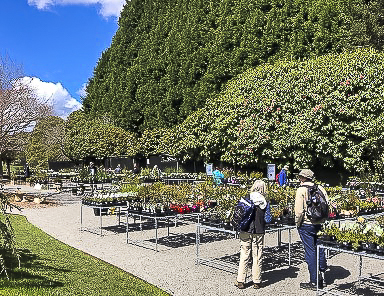 Whilst half of our group stayed here and enjoyed a beautiful lunch and a treat from their onsite café, the other half were met by a local Guide and taken to Robertson Rainforest Reserve or Brush as he referred to it, for a walk through this remnant endangered ecological community. The rainforest is a warm or cool temperate rainforest with quite a dense structure dominated by Possumwood ( Quintinea Sieberi), Sassafras (Doryphora sassafras), Blackwood (Acacia melanoxylon) and Featherwood (Polyasma cunninghamii). Shrubs include Tree Violet (Hymenanthera dentata), Prickly Coprosma (Coprosma quadrifida), and Brush Pepperbush (Tasmanian Insipida). At ground level there are a variety of ferns. |
|
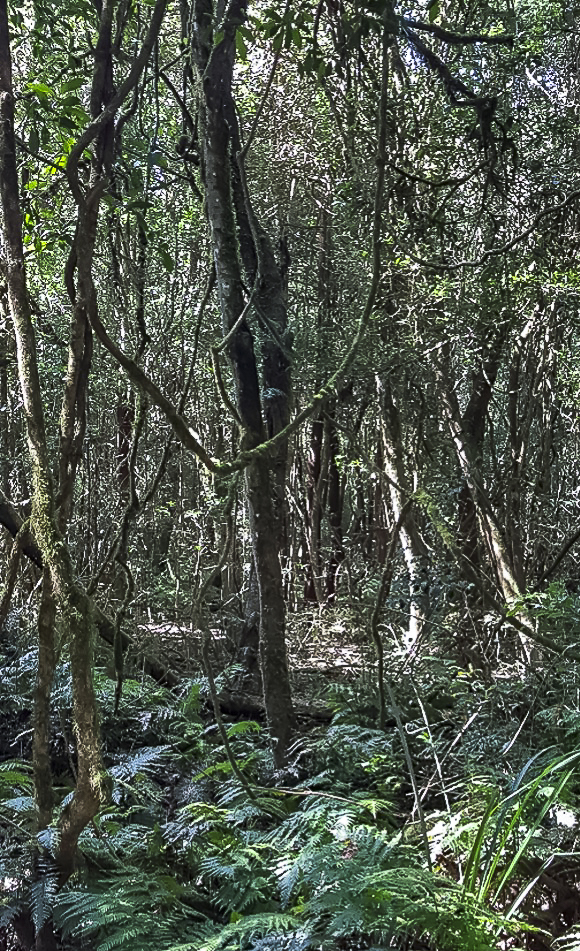 There are two main stands of Robertson Rainforest in the Southern Highlands, the main site is here on the outskirts of the township on the Robertson Plateau and the other site is on the higher parts of the Cambewarra Range where it is less widespread. It also occurs elsewhere in the Sydney Bioregion. The rainforest prefers highly fertile soils derived from basalt and basanite, on gently undulating parts of the Robertson Plateau at an altitude of between 500- 700 metres. There is about 400-600 hectares of this remnant rainforest still surviving with most of it occurring on private land, hence it is quite fragmented due to development from farming activities, and subdivision for urban use. Other threats include invasion by non- native species ( weeds and exotics), grazing and trampling by deer, impacts from climate change such as reduced rainfall, drying winds and increased storm events; disturbance from inappropriate collection of bush rock and pile burning/fire regimes ( Reference: www.environment.nsw.gov.au/ ). |
Conference days
Monday, Tuesday and Thursday were full programmes whereby delegates listened to a variety of speakers at Kiama Pavilion which is located on the coast where beautiful views of the beaches and ocean could be enjoyed from the car park and the verandas around the Pavilion during our breaks.
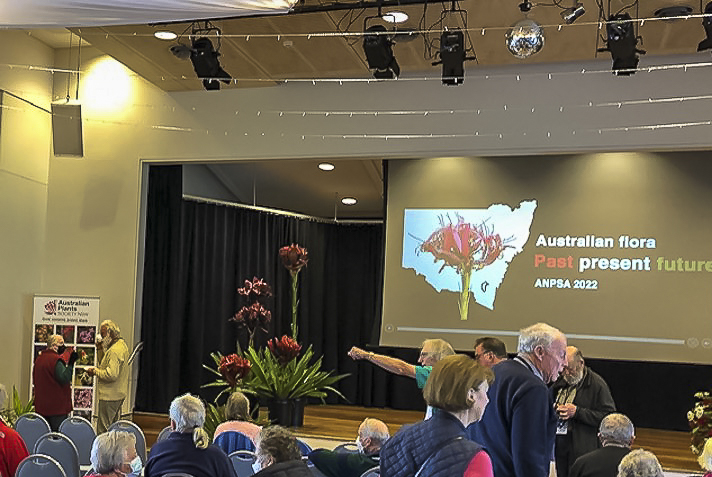 |
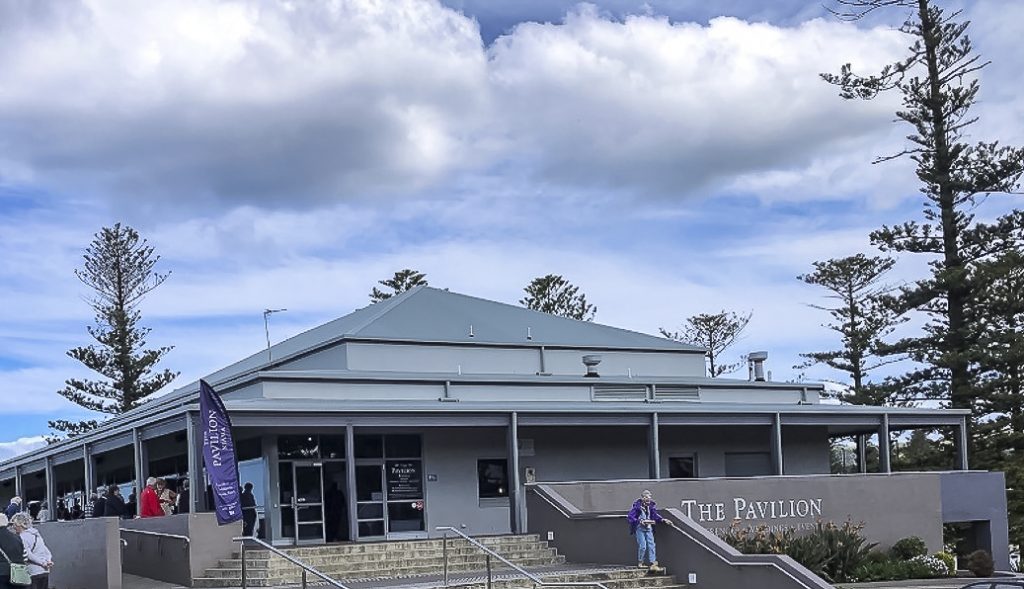 |
Monday
Starting early on Monday September 12, we received a Welcome to Country from Gwenda Jarrett a traditional owner, on behalf of the Dharawahl and Yulaga peoples on whose country the Conference was being held. Gwenda is from the Gerringong area.
The Welcome was followed by a talk from Jane Stroud, the CEO of Kiama Shire Council who has a very strong interest in the environment sharing that she had previously undertaken studies in English Literature and Environmental Planning. She expressed the importance of retaining old stands of forest and rainforests in the region, spoke highly of the local Arboretum and especially the work undertaken by the Shire’s team of arborists who are involved with all the Significant Trees and restorative work being undertaken. One of her other interests is the link between indigenous Story and Songlines with the environment and native flora.
The Keynote address was delivered by Professor David Keith, Professor of Botany at the UNSW who works as a botanist and ecologist in the areas of vegetation dynamics, population and ecosystem modelling and fire ecology.
His talk centred upon the past, present and future of Australian plants.
As part of this topic, David spoke about the history of Australia’s flora from the time of Gondwanaland through to the present. He shared with us the reasons as to why Australian plants are unique. This includes aridification (xeromorphic traits), Nutrient poverty (scleromorphic traits), Fire Regimes (pyromorphic traits) and Isolation. It is now known that Sclerophyll forests have been here for around 100 million years together with rainforests.
Alpine Herb fields have existed for around 2-5 million years, but due to climate change will need to undergo adaptations for upward migration.
Since colonisation one of the big vegetation losses have been grasslands and grassy woodlands and during this time there have been 26,242 plant species introduced to Australia. There is about 3,000 weeds of national significance (WONS) and 6,000 plants behaving like weeds especially overseas but not so much yet here in this country.
Amongst indigenous plant species 1402 are listed under the EPBC Act; 37 species are extinct, 2200 listed as critically endangered, 559 endangered and 585 listed as vulnerable under the IUCN classification. David also shared that at least 60% of plants endemic to Australia have not yet been assessed and the extinction rate is more than likely underestimated.
In terms of the future under climate change, things will be difficult especially for plants, animals and marine species especially with the projected shifts required for these organisms to move to higher latitudes and altitudes and whether they will be able to adapt in time to survive.
Intensifying drought conditions in Australia will have a significant impact on forest ecosystems which are predicted to contract. For instance, the Jarrah forest in South West WA, will come under threat due to changes in soil composition resulting in the inability to hold sufficient water to meet the needs of the trees.
Our next speaker was Dr Tim Morrow a recently retired Meteorologist with the Bureau of Meteorology, who spoke on the topic “An Ancient Forecast”. Tim provided us with an example where aboriginal people living in the south west of WA about 35,000 -40,000 years ago wore possum skins to keep warm from the freezing weather conditions. Amongst his interesting slides was one depicting the position of the continental shelf from about 25,000-16,000 years ago when all the river tributaries coursed its surface. It took people five days to reach the coast as it was two hundred miles further east than what it is today! So often we read about under sea mountains, volcanoes and canyons, but it was also interesting to learn about the existence of river systems too!
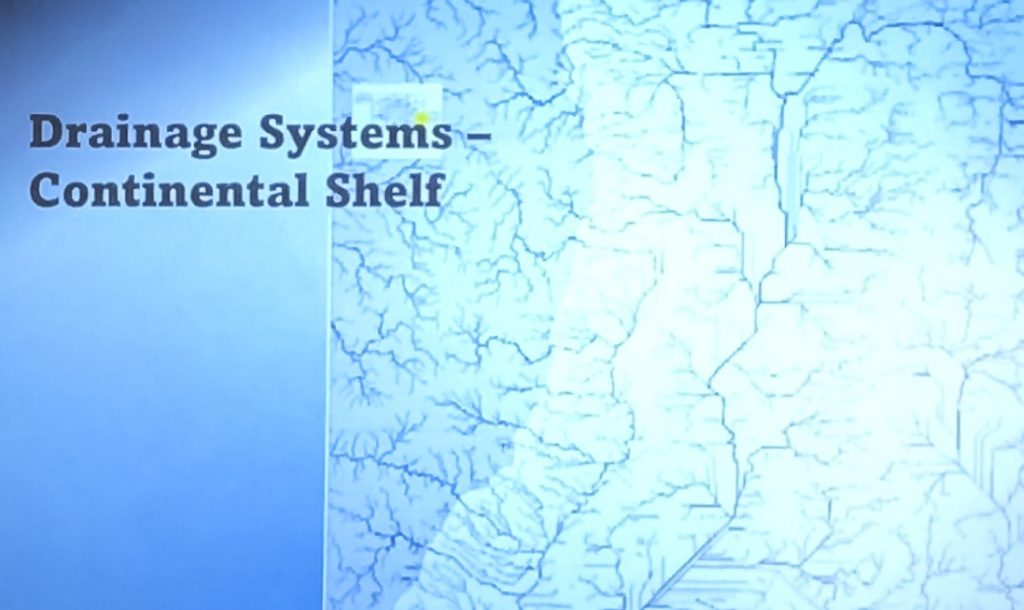
Associate Professor Scott Mooney from the School of Biological, Earth and Environmental Sciences at the UNSW spoke to us about “Fire, Humans and climate as drivers of environmental change in eastern Australia”. In short there are concerns that although fire has always shaped the Australian landscape for many years, in more recent years such as with the 2019-20 Bushfires, under human induced climate change are we moving to a period of more intense fires increasing in frequency which will interrupt the in- ground seed bank and change the composition of forests and other vegetation types as we know it today.
Part of his work involves taking core samples from the sediments in elevated peat swamps. The presence of charcoal layers helps with assessing and determining fire frequency.
If you would like to know more about this fascinating subject, one of the books recommended was
“ Flammable Australia: Fire Regimes, Biodiversity and Eco systems in a Changing Environment by Ross Bradstock. CSIRO Publishing.
After lunch we had the pleasure of listening to Clarence Slockee from Gardening Australia fame who spoke about “ a day in the life of First Nations People, thousands of years ago”. He shared about the indigenous plants which can be safely eaten and especially about his native rooftop garden in Sydney’s South Eveleigh precinct which has more than 2000 plants with more than 60 being edible and having medicinal qualities. He currently runs his own landscape design company known as Jiwah which employs young Aboriginal people.
He also shared that when aboriginal women go out into the bush to forage for food, before they pick any of the berries or other fruit from a plant, that they ask it for permission to do so. Not all the fruit is harvested, some is left behind so it can fall to the ground and germinate naturally.
Following Clarence, we had the pleasure of learning about some of the APS Study Groups. The first speaker was Dr Lyndal Thorburn on behalf of the Eremophila Study Group who shared that the Group was celebrating 50 years and there was to be a cake cutting ceremony later in the afternoon for members.
Lyndal mentioned there was about 245 varieties of Eremophila with the blue, purple, pink and white flowering plants being pollinated by Insects and birds pollinating the orange flowering varieties. If members are enthusiastic about grafting, then Myoporum is a good species to use as rootstock for attaching the scion. However, one of the issues with cutting and grafting is the loss of genetic diversity. Nurseries are currently selling E. Racemorsa. In the wild this variety has yellow buds with pink flowers, but the nurseries are selling their version which has yellow buds and white flowers. The Study Group is currently working with ABG at Mt Annan to conserve the species in the wild. The Group has good links with the Arid Gardens Arboretum in Port Augusta SA, and are also planning to approach the National Arboretum in Canberra. In addition they hope to raise education about eremophilas with the Canberra Institute of TAFE and Local Government Associations to encourage growth of the species in home gardens.
From the Grevillea Study Group Peter Olde described the botanical work and theory surrounding Grevilleas as being in a “state of flux” from a taxonomic viewpoint. Previously taxonomy was based on morphology, ie, the physical attributes like size, shape colour and body structure. He mentioned the work of Robert Brown and advised that Australia’s flora is based on Brown’s taxonomy.
Although we can key a species out with the use of botanical keys, using genetics is fast out pacing this method in helping botanists to decide the correct species/genus for certain plant groups through the process of DNA Barcoding which is based on DNA sequencing. Peter spoke about Charles Darwin and the theory of evolution through to the work of American paleontologist Joel Cracraft and his research into fossilised pollens being used to date the age of plants.
Grevilleas ( Protaceae) have a long history and one such example given was Grevillea hilliana also known as White Yiel Yiel which is endemic to north-eastern NSW, and was first described in 1857 by Ferdinand von Mueller!
Our final speaker for the day on behalf of Lawrie Smith, the coordinator of the Garden Design Study Group, was Ellis Stones who spoke about the history of garden design in Australia. He mentioned the Eltham period which saw native plant gardens being designed by people such as Edna Walling and Gordon Ford. Also mentioned was Marion Blackwall in Western Australia and her work in designing Bush Gardens and Sam Cox with his naturalistic garden style. Bruce Mackenzie with his unique “Spirit of Place” designs where he responded to the local environment when working at a particular site. Lawrence ( Lawrie) Smith ( AM), was involved with the streetscape and parklands in Roma ( Qld), also the inner city areas of Brisbane and the Longreach Walkway which runs beside the Matilda Highway from the edge of the township into the town itself.
Mention was made too about the work of Phillip Johnson in creating gardens which were both sustainable and functional and he has also won awards at the Chelsea Garden Show.
Tuesday
Tuesday morning saw delegates attending open forums/chat rooms across two sites, one at the Pavilion and the other at the Kiama Anglican Church Hall on the other side of the oval. There was a choice of 13 guest speakers and each of us had the opportunity to select 5 presenters. Jim and I listened to Prof Martin Backor from the Pavol Jozet Safarik University in Slovakia speak about the biological and ecological role of Lichens which live in a symbiotic relationship between an algae and a fungi. Martin pointed out that lichens produce many unique compounds that have important biological, ecological, and pharmaceutical roles. This may include antimicrobial activity, anti-herbivory, chelating of heavy metals and UV Light screening.
Following Martin’s talk we met with an energetic speaker by the name of Patsy Nagle who currently works as a Ranger for NPWS and also with the University of Wollongong in the Janet Cosh Herbarium. She is also a member of the Menai Wildflower Group and helps in their nursery. In addition she also assists students and volunteers with plant identification, undertakes pest and weed control and is also involved with post fire rehabilitation. Patsy describes herself as having “a long love affair with Australian Flora”. At the back of the room Patsy had laid out a variety of brochures about plants of the Illawarra Region and encouraged everyone to pick up a copy.
From here we headed quickly over to the Anglican Church Hall to listen to Dr. Kevin Mills speak about the Impacts which Climate Change was going to have upon the Rainforests especially in the Illawarra region.
Australia wide there is only about 20,000 sq klm across the entire country made up of rainforest. Rainforests have not adapted well to severe droughts nor being burnt severely as we saw in 2019-20 with the Bushfires along the entire length of the Great Dividing Range where 35% of rainforest was burnt. Moving forward into the future with Climate change it will be the extremes in temperature which matter the most and how frequent these events occur. When driving south the rainforest structure changes from dense woody vegetation to less woody plants. As the rainforest disappears, schlerophyll forest begins to proliferate.
Kevin has written several books, one titled “ Rainforest of the Illawarra District”.
From Kevin, we then heard from Dr. Janet Pierson who trained in Montana USA and currently works as a Senior Ecologist with a team of 2 Botanists for the Australian Wildlife Conservancy. This was a great talk and one which I enjoyed immensely as it was about providing safe havens both inside and outside a Feral Proof Fence in the Pilliga Scrub. Although most of her work has involved fauna such as Bettongs at Mulligans Flat just outside of Canberra, now they are also looking at plants, in particular the Donkey Orchid and the Cobar Greenhood which are both listed as Critically Endangered and have been found growing inside and outside the fence.
After a scrumptious morning tea we listened to Catriona and Phil Trickett (Isopogon and Petrophile Study Group) talk about grafting techniques for native plants.( Ian has kindly added an attachment regarding the procedure.)
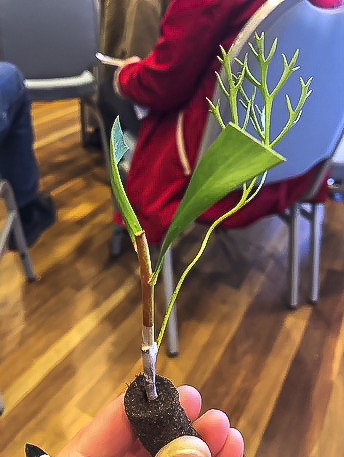 |
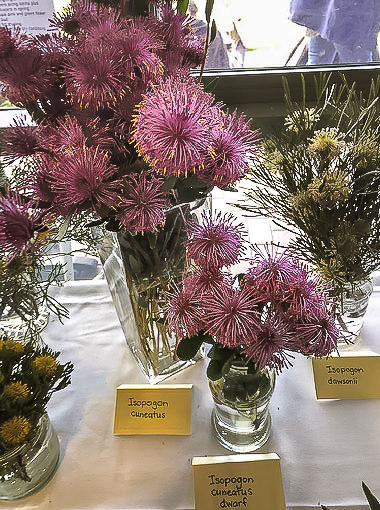 |
For the afternoon sessions we had a very interesting talk from Aunty Joyce Donovan a Wodi Wodi and Dharawal elder who spoke about native plant medicines of the local Illawarra area together with the protocols and customs for their use and how in turn the plants are linked to the culture of the South Coast people.
One interesting topic was the use of spider webs (minus the spider) for assisting with forming a blood clot following scratches from say walking through the bush. Also, Native Pig Face (Carpobrotus glaucescens ) can be used as an antiseptic and also for sore throats as a gargle.
The pith from the Cabbage Tree Palm can be used for a sore throat and the fibres used to make fishing lines.
Aboriginal people were healers and the bush to them was like a pharmacy. Today they can no longer obtain many of their native medicinal plants due to urban development.
Jane Fountain, the ANPSA Group Coordinator also spoke about the various study groups and pointed out all the brochures about each of these groups to the delegates if they were thinking about joining a group.
Warwick Varley briefly shared about Eucalypts. By profession he is an arborist so has a wealth of knowledge garnered across 34 years and has lived in the Illawarra area since 1984. He also teaches at TAFE and is the leader of the Eucalyptus Study Group. Over 50 species of eucalypts exist throughout the Illawarra Region and soil and temperature play a big part in what variety grows where.
Finally, we heard from Karlo Taliana who set up the online Banksia Lovers group which has 20,000 members. He is also a member of the Banksia Study Group. Wherever possible he promotes the Study Group to members who come online to share their insights and photos about Banksia. A discussion ensued about the different types of Banksia, so many in the audience who had some depth of experience also contributed to the discussion.
The three days were certainly full of things to do and it was a real experience to attend such an event and learn from the experts, meet new friends and catch up with others met from meetings and trips elsewhere via the wonderful world of Australian native plants.
Many thanks to Heather Miles (President of the APS NSW) and all her hardworking team for the wonderful organisation which went into making the entire conference so successful.
The next Biennial Conference for ANPSA will be held in Victoria in 2024… so get ready!
Further Reading:
- How Aboriginal Australians coped with the last Ice Age- sciencedaily.com/releases
Published by Researchers with James Cook University.
- Opinion The last ice age tells us why we need to care about a 2 degree C change in temperature. https://newsroom.unsw.edu.au/news/science-tech

